The global multihead weighers market is valued at USD 2,156 million in 2025 and is set to reach USD 3,524 million by 2035, growing at a CAGR of 5.1%. The market stands at the forefront of a transformative decade that promises to redefine food packaging automation infrastructure and precision weighing excellence across food processing facilities, snack manufacturers, pharmaceutical companies, and industrial packaging sectors. The market's journey from USD 2,156 million in 2025 to USD 3,524 million by 2035 represents substantial growth, demonstrating the accelerating adoption of automated weighing systems and sophisticated portion control technology across production lines, quality assurance operations, packaging automation, and high-speed manufacturing applications.
The first half of the decade (2025 to 2030) will witness the market climbing from USD 2,156 million to approximately USD 2,743 million, adding USD 587 million in value, which constitutes 43% of the total forecast growth period. This phase will be characterized by the rapid adoption of Industry 4.0 manufacturing, driven by increasing demand for precision weighing accuracy and enhanced production efficiency requirements worldwide. Advanced load cell technology and automated portion control capabilities will become standard expectations rather than premium options.
The latter half (2030 to 2035) will witness sustained growth from USD 2,743 million to USD 3,524 million, representing an addition of USD 781 million or 57% of the decade's expansion. This period will be defined by mass market penetration of intelligent weighing systems, integration with comprehensive production platforms, and seamless compatibility with existing packaging line infrastructure. The market trajectory signals fundamental shifts in how food processors and manufacturers approach automated weighing solutions, with participants positioned to benefit from sustained demand across multiple industrial segments.
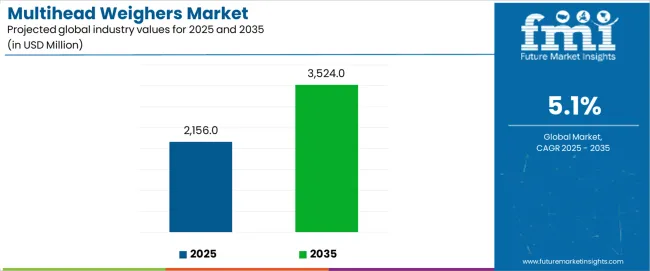
The multihead weighers market demonstrates distinct growth phases with varying market characteristics and competitive dynamics. Between 2025 and 2030, the market progresses through its automation adoption phase, expanding from USD 2,156 million to USD 2,743 million with steady annual increments averaging 4.9% growth. This period showcases the transition from manual weighing operations to advanced automated systems with enhanced accuracy control and integrated data management becoming mainstream features.
The 2025 to 2030 phase adds USD 587 million to market value, representing 43% of total decade expansion. Market maturation factors include standardization of weighing specifications, declining costs for precision load cell production, and increasing manufacturer awareness of multihead weigher benefits reaching 80-85% effectiveness in high-speed packaging applications. Competitive landscape evolution during this period features established manufacturers like Ishida and Yamato Scale expanding their technology portfolios while new entrants focus on specialized combination weighing solutions and enhanced connectivity features.
From 2030 to 2035, market dynamics shift toward advanced integration and multi-industry deployment, with growth accelerating from USD 2,743 million to USD 3,524 million, adding USD 781 million or 57% of total expansion. This phase transition logic centers on universal weighing systems, integration with automated packaging equipment, and deployment across diverse manufacturing scenarios, becoming standard rather than specialized machinery. The competitive environment matures with focus shifting from basic accuracy to comprehensive production performance and compatibility with high-speed filling operations.
At-a-Glance Metrics
| Metric | Value |
|---|---|
| Market Value (2025) | USD 2,156 million |
| Market Forecast (2035) | USD 3,524 million |
| Growth Rate | 5.10% CAGR |
| Leading Head Count | 10-14 Heads |
| Primary Application | Food Processing |
The market demonstrates strong fundamentals with 10-14 head configurations capturing a dominant share through optimal balance of accuracy and throughput capabilities. Food processing applications drive primary demand, supported by increasing automation requirements and precision weighing solutions. Geographic expansion remains concentrated in developed markets with established manufacturing infrastructure, while emerging economies show accelerating adoption rates driven by industrial modernization projects and rising production efficiency activity.
The multihead weighers market represents a compelling intersection of packaging automation, precision weighing, and production efficiency management. With robust growth projected from USD 2,156 million in 2025 to USD 3,524 million by 2035 at a 5.10% CAGR, this market is driven by increasing food processing automation trends, pharmaceutical packaging requirements, and commercial demand for high-accuracy weighing formats.
The market's expansion reflects a fundamental shift in how manufacturers and processors approach automated weighing infrastructure. Strong growth opportunities exist across diverse applications, from food processing facilities requiring precision portion control to pharmaceutical companies demanding accuracy validation. Geographic expansion is particularly pronounced in Asia-Pacific markets, led by China (6.2% CAGR) and India (5.8% CAGR), while established markets in Europe and North America drive innovation and specialized segment development.
The dominance of 10-14 head configurations and food processing applications underscores the importance of proven weighing technology and operational efficiency in driving adoption. System complexity and integration requirements remain key challenges, creating opportunities for companies that can deliver reliable performance while maintaining operational simplicity.
Market expansion rests on three fundamental shifts driving adoption across manufacturing and packaging sectors. Production automation creates compelling advantages through multihead weighing systems that provide comprehensive accuracy control with enhanced throughput, enabling manufacturers to optimize packaging operations and maintain quality standards while justifying equipment investments over manual weighing methods. Consumer demand evolution accelerates as food processors worldwide seek precision portion control that delivers consistent product weight directly to packaging environments, enabling cost optimization that aligns with manufacturing efficiency expectations and maximizes production output. Manufacturing operations optimization drives adoption from processing facilities requiring efficient weighing solutions that maximize productivity per line while maintaining accuracy standards during high-speed production operations.
However, growth faces headwinds from integration complexity variations that differ across production facilities regarding equipment compatibility and line speeds, potentially limiting performance reliability in ultra-high-volume manufacturing categories. System maintenance requirements also persist regarding calibration protocols and cleaning procedures that may increase operational complexity in markets with demanding hygiene standards.
Primary Classification: The market segments by head count into 8-10 heads, 10-14 heads, 14-16 heads, and 16+ heads categories, representing the evolution from basic weighing systems to advanced multi-point accuracy formats for comprehensive production operations.
Secondary Breakdown: Application segmentation divides the market into food processing, pharmaceuticals, chemicals, cosmetics, and others sectors, reflecting distinct requirements for accuracy, speed, and contamination control performance.
Regional Classification: Geographic distribution covers Asia Pacific, Europe, North America, Latin America, and the Middle East & Africa, with developed markets leading adoption while emerging economies show accelerating growth patterns driven by industrial automation programs.
The segmentation structure reveals technology progression from standard multi-head configurations toward integrated weighing platforms with enhanced data connectivity and production control capabilities, while application diversity spans from food processing to pharmaceutical operations requiring comprehensive accuracy solutions and automated packaging systems.
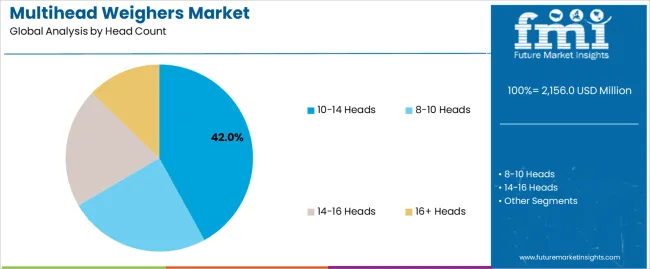
10-14 heads segment is estimated to account for 42% of the multihead weighers market share in 2025. The segment's leading position stems from its fundamental role as a critical component in balanced production applications and its extensive use across multiple food processing and packaging sectors. 10-14 heads' dominance is attributed to its optimal accuracy-to-speed ratio, including reliable weighing precision, excellent throughput performance, and balanced cost structure that make it indispensable for standard manufacturing operations.
Market Position: 10-14 head systems command the leading position in the multihead weighers market through proven manufacturing technologies, including comprehensive weighing algorithms, uniform load cell distribution, and reliable feeding performance that enable processors to deploy equipment across diverse production applications.
Value Drivers: The segment benefits from manufacturer preference for proven weighing configurations that provide exceptional accuracy-throughput balance without requiring specialized maintenance protocols. Cost-effective operation enables deployment in food processing, pharmaceutical, and industrial applications where production efficiency and weighing precision represent critical selection requirements.
Competitive Advantages: 10-14 head systems differentiate through optimal performance balance, proven reliability characteristics, and compatibility with standard packaging equipment that enhance production quality while maintaining economical operation profiles suitable for diverse manufacturing applications.
Key market characteristics:
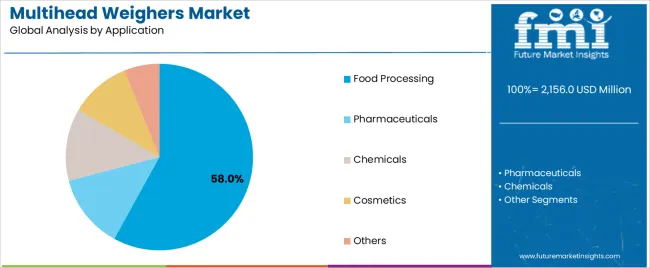
Food processing segment is projected to hold 58% of the multihead weighers market share in 2025. The segment's market leadership is driven by the extensive use of multihead weighers in snack packaging, confectionery production, frozen food processing, and fresh produce handling, where equipment serves as both portion control systems and quality assurance tools. The food industry's consistent investment in automation efficiency supports the segment's dominant position.
Market Context: Food processing applications dominate the market due to widespread adoption of automated weighing and increasing focus on production efficiency, cost control, and quality consistency that extend manufacturing value while maintaining portion accuracy.
Appeal Factors: Food processors prioritize weighing accuracy, easy cleaning procedures, and integration with existing packaging lines that enable coordinated deployment across multiple production points. The segment benefits from substantial food industry growth and regulatory standards that emphasize portion control accuracy for consumer protection.
Growth Drivers: Packaging automation programs incorporate multihead weighers as standard efficiency tools for high-speed production. At the same time, food safety initiatives are increasing demand for hygienic weighing systems that comply with processing regulations and enhance quality control programs.
Market Challenges: Cleaning protocol requirements and product changeover procedures may limit deployment flexibility in ultra-sensitive food operations or extreme contamination-control scenarios.
Application dynamics include:
Growth Accelerators: Manufacturing automation drives primary adoption as multihead weighing systems provide exceptional accuracy control that enables precision portion management without compromising production speed, supporting facility efficiency enhancement and cost reduction that require automated weighing formats. Industrial modernization accelerates market growth as processors seek reliable production equipment that maintains weighing consistency during high-speed operations while enhancing manufacturing flexibility through advanced control design. Quality assurance requirements increase worldwide, creating sustained demand for precision weighing systems that complement production standards and provide competitive advantages in accuracy verification.
Growth Inhibitors: Integration complexity challenges differ across manufacturing facilities regarding equipment capability and line compatibility, which may limit market penetration and efficiency in high-volume categories with demanding production requirements. System maintenance requirements persist regarding calibration protocols and cleaning procedures that may increase operational costs in hygiene-sensitive applications with strict quality specifications. Market fragmentation across multiple head configurations and control types creates compatibility concerns between different packaging equipment and existing production infrastructure.
Market Evolution Patterns: Adoption accelerates in food processing and pharmaceutical sectors where precision weighing justifies equipment investments, with geographic concentration in developed markets transitioning toward mainstream adoption in emerging economies driven by industrial culture development and manufacturing automation expansion. Technology development focuses on enhanced weighing accuracy, improved control systems, and integration with automated packaging lines that optimize production quality and operational efficiency. The market could face disruption if alternative weighing technologies or automation innovations significantly challenge multihead weigher advantages in manufacturing applications.
The multihead weighers market demonstrates varied regional dynamics with Growth Leaders including China (6.2% CAGR) and India (5.8% CAGR) driving expansion through industrial automation and manufacturing modernization. Steady Performers encompass the USA (5.4% CAGR), Germany (4.9% CAGR), and Japan (4.6% CAGR), benefiting from established manufacturing sectors and advanced packaging adoption.
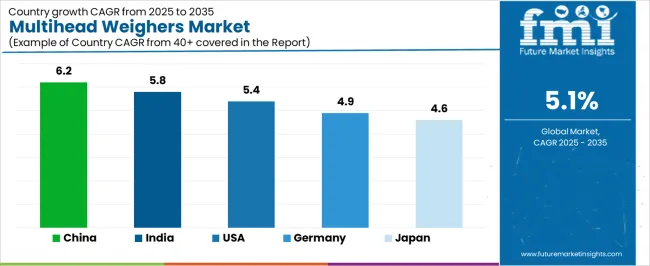
| Country | CAGR (2025 to 2035) |
|---|---|
| China | 6.2% |
| India | 5.8% |
| USA | 5.4% |
| Germany | 4.9% |
| Japan | 4.6% |
Regional synthesis reveals Asia-Pacific markets leading growth through industrial automation expansion and manufacturing development, while European countries maintain steady expansion supported by traditional processing heritage and precision equipment requirements. North American markets show strong growth driven by food processing modernization and pharmaceutical applications.
China establishes regional leadership through explosive manufacturing expansion and comprehensive industrial modernization, integrating advanced multihead weighing systems as standard components in processing operations and automated packaging applications.
The country's 6.2% CAGR through 2035 reflects production efficiency evolution promoting automated weighing adoption and domestic manufacturing activity that mandate the use of precision weighing equipment in production operations. Growth concentrates in major industrial centers, including Shanghai, Guangzhou, and Shenzhen, where manufacturers showcase integrated weighing systems that appeal to processors seeking reliable production equipment and international manufacturing standards.
Chinese manufacturers are developing innovative weighing solutions that combine local production advantages with international precision specifications, including enhanced load cell technology and advanced control capabilities.
Strategic Market Indicators:
The Indian market emphasizes manufacturing applications, including rapid industrial development and comprehensive production modernization that increasingly incorporates multihead weighers for automated packaging and processing applications. The country is projected to show a 5.8% CAGR through 2035, driven by massive manufacturing activity under industrial modernization initiatives and commercial demand for affordable, high-accuracy weighing systems. Indian manufacturers prioritize cost-effectiveness with multihead weighers delivering precision weighing through economical equipment usage and efficient production capabilities.
Technology deployment channels include major processing companies, packaging manufacturers, and industrial suppliers that support high-volume usage for domestic and export applications.
Performance Metrics:
The USA market emphasizes advanced weighing features, including innovative accuracy technologies and integration with comprehensive production platforms that manage automated packaging, quality control, and efficiency applications through unified weighing systems. The country is projected to show a 5.4% CAGR through 2035, driven by food processing expansion under automation trends and commercial demand for premium, reliable weighing systems. American manufacturers prioritize production efficiency with multihead weighers delivering comprehensive accuracy through refined control and monitoring capabilities.
Technology deployment channels include major food processors, packaging equipment suppliers, and specialized weighing manufacturers that support custom development for premium operations.
Performance Metrics:
In Munich, Frankfurt, and Hamburg, German manufacturers and processing companies are implementing advanced multihead weighing systems to enhance production capabilities and support manufacturing excellence that aligns with quality protocols and efficiency standards. The German market demonstrates sustained growth with a 4.9% CAGR through 2035, driven by traditional manufacturing innovation programs and industrial investments that emphasize premium weighing systems for food processing and pharmaceutical applications. German processing facilities are prioritizing weighing systems that provide exceptional accuracy performance while maintaining compliance with quality standards and minimizing production variation, particularly important in traditional manufacturing operations and specialized processing facilities.
Market expansion benefits from manufacturing excellence programs that mandate enhanced precision in equipment specifications, creating sustained demand across Germany's processing and manufacturing sectors, where accuracy integrity and system reliability represent critical requirements.
Strategic Market Indicators:
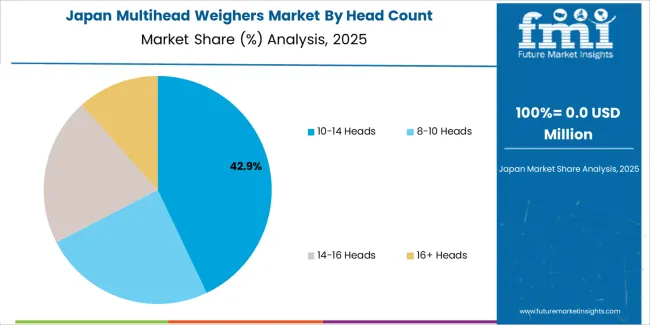
Japan's sophisticated manufacturing market demonstrates meticulous weighing deployment, growing at 4.6% CAGR, with documented operational excellence in precision weighing and production automation applications through integration with existing packaging systems and quality assurance infrastructure. The country leverages engineering expertise in equipment manufacturing and control precision to maintain market leadership. Manufacturing centers, including Tokyo, Osaka, and Nagoya, showcase advanced installations where weighing systems integrate with comprehensive production platforms and automation systems to optimize manufacturing quality and operational efficiency.
Japanese manufacturers prioritize weighing precision and system consistency in equipment development, creating demand for premium multihead weighing systems with advanced features, including ultra-reliable accuracy and integration with automated production protocols. The market benefits from established manufacturing infrastructure and willingness to invest in specialized weighing technologies that provide superior precision control and regulatory compliance.
Market Intelligence Brief:
The multihead weighers market in Europe is projected to grow from USD 647 million in 2025 to USD 978 million by 2035, registering a CAGR of 4.2% over the forecast period. Germany is expected to maintain its leadership position with a 32.4% market share in 2025, declining slightly to 32.0% by 2035, supported by its manufacturing excellence and major industrial centers, including Bavaria and North Rhine-Westphalia.
Italy follows with a 21.6% share in 2025, projected to reach 22.1% by 2035, driven by comprehensive food processing culture and packaging industry adoption. France holds a 18.3% share in 2025, expected to maintain 18.6% by 2035 through established food manufacturing sectors and premium equipment adoption. United Kingdom commands a 14.7% share, while Netherlands accounts for 8.2% in 2025. The Rest of Europe region is anticipated to gain momentum, expanding its collective share from 4.8% to 5.1% by 2035, attributed to increasing manufacturing development in Eastern European countries and emerging Nordic processing brands implementing advanced weighing programs.
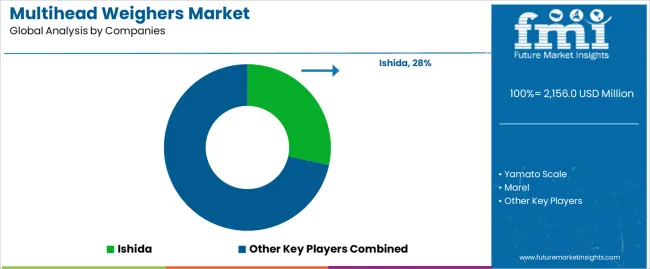
The multihead weighers market operates with moderate concentration, featuring approximately 15-20 participants, where leading companies control roughly 45-52% of the global market share through established distribution networks and comprehensive weighing technology capabilities. Competition emphasizes accuracy performance, throughput features, and integration compatibility rather than price-based rivalry.
Market leaders encompass Ishida, Yamato Scale, and Marel, which maintain competitive advantages through extensive weighing manufacturing expertise, global service networks, and comprehensive technical support capabilities that create customer loyalty and support processing requirements. These companies leverage decades of precision weighing experience and ongoing accuracy technology investments to develop advanced multihead systems with exceptional weighing precision and production control features.Ishida leads with 28% share.
Specialty challengers include MULTIPOND, Ilapak, and Heat and Control, which compete through specialized processing innovation focus and efficient weighing solutions that appeal to food processors seeking premium accuracy formats and custom integration flexibility. These companies differentiate through engineering emphasis and specialized manufacturing application focus.
Market dynamics favor participants that combine reliable weighing performance with advanced integration support, including production management and control precision. Competitive pressure intensifies as traditional packaging machinery manufacturers expand into weighing systems. At the same time, specialized automation suppliers challenge established players through innovative accuracy technologies and cost-effective production targeting emerging manufacturing segments.
| Item | Value |
|---|---|
| Quantitative Units | USD 2,156 million |
| Head Count | 8-10 Heads, 10-14 Heads, 14-16 Heads, 16+ Heads |
| Application | Food Processing, Pharmaceuticals, Chemicals, Cosmetics, Others |
| Regions Covered | Asia Pacific, Europe, North America, Latin America, Middle East & Africa |
| Countries Covered | China, U.S., Germany, Japan, India, and 25+ additional countries |
| Key Companies Profiled | Ishida, Yamato Scale, Marel, MULTIPOND, Ilapak, Heat and Control |
| Additional Attributes | Dollar sales by head count and application categories, regional adoption trends across Asia Pacific, Europe, and North America, competitive landscape with weighing equipment manufacturers and packaging machinery suppliers, processor preferences for accuracy performance and integration compatibility, integration with packaging equipment and control systems, innovations in load cell technology and production control, and development of specialized weighing solutions with enhanced precision capabilities and user-friendly features |
The global multihead weighers market is estimated to be valued at USD 2,156.0 million in 2025.
The market size for the multihead weighers market is projected to reach USD 3,524.0 million by 2035.
The multihead weighers market is expected to grow at a 5.1% CAGR between 2025 and 2035.
The key product types in multihead weighers market are 10-14 heads, 8-10 heads, 14-16 heads and 16+ heads.
In terms of application, food processing segment to command 58.0% share in the multihead weighers market in 2025.






Full Research Suite comprises of:
Market outlook & trends analysis
Interviews & case studies
Strategic recommendations
Vendor profiles & capabilities analysis
5-year forecasts
8 regions and 60+ country-level data splits
Market segment data splits
12 months of continuous data updates
DELIVERED AS:
PDF EXCEL ONLINE
Breaking Down Market Share in Multihead Weighers
Western Europe Multihead Weigher Market Analysis – Trends & Forecast 2024-2034
Japan Multihead Weigher Market Analysis – Trends & Forecast 2024-2034
Korea Multihead Weigher Market Insights – Growth & Forecast 2024-2034

Thank you!
You will receive an email from our Business Development Manager. Please be sure to check your SPAM/JUNK folder too.
Chat With
MaRIA